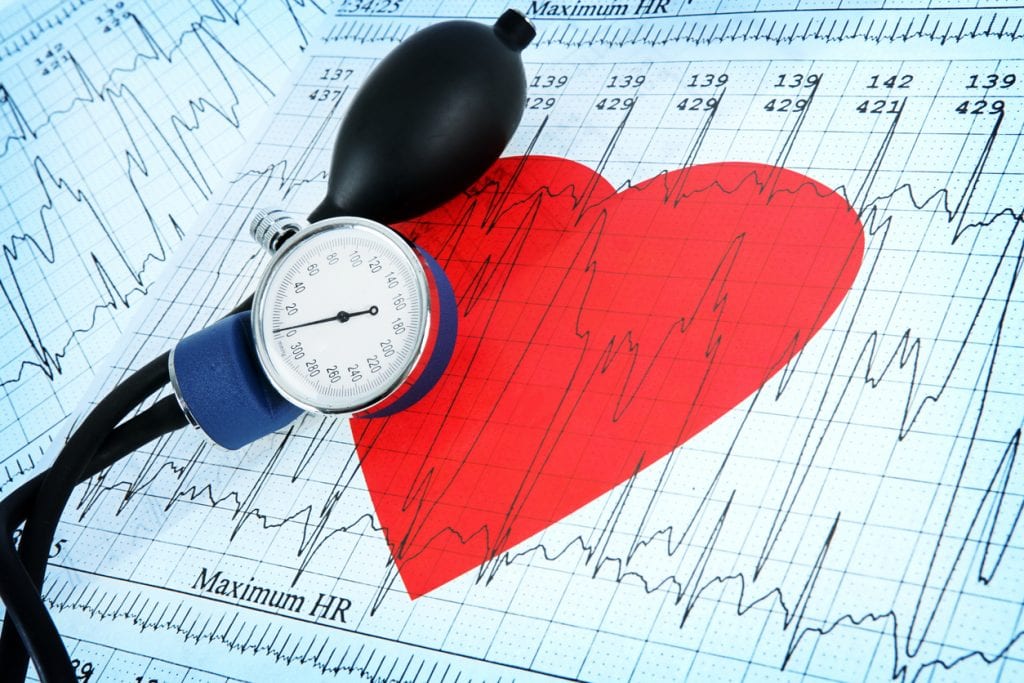HEART DISEASE – WEAR RED FOR SOMEONE CLOSE TO YOUR HEART THIS FEBRUARY

A blood pressure monitor on a printout of a heart and heartbeat graph.
The month of February, everyone is invited to wear the colour red for someone close to your heart. Heart disease is Australia’s leading cause of death, killing one Australian every 28 minutes. *
By becoming involved in Wear Red and Donate you are helping to make life-saving medical breakthroughs to address the devastation that heart disease causes too many Australian communities and families.
Heart disease is Australia’s leading cause of death, with 18,590 deaths attributed to heart disease in Australia in 2019.
The Wear Red and Donate event is as easy as wearing the colour red while donating to Heart Research Australia. Honour those close to your heart. Raise money for life-saving research, raise awareness for heart disease and help keep families together for longer.
What is heart disease?
An umbrella term, heart disease describes a range of conditions that affect your heart. Heart diseases include blood vessel diseases, such as coronary artery disease; heart rhythm problems (arrhythmias); and heart defects you’re born with (congenital heart defects), among others.
‘Heart disease’ and ‘cardiovascular disease’ are interchangeable terms, while cardiovascular disease refers to conditions of narrowed or blocked blood vessels that can lead to a heart attack, chest pain (angina) or stroke. Other heart conditions, such as those that affect your heart’s muscle, valves or rhythm, also are considered forms of heart disease.
Keeping your heart healthy, whatever your age, is of the most important things you can do to protect your health.
By improving your lifestyle, including your of fitness and diet, you can minimise your risk of cardiovascular disease. Even if you have two or more risk factors, you can still make changes that will reduce your chances of developing heart problems.
However, several things are known to increase the risk of developing heart disease. People with two or more risk factors in their lives are much more likely to get heart disease than those with one or none. The heart lies in the middle of your chest, just behind the breastbone.
Your heart is a hollow muscular organ, about the size of your clenched fist. It pumps blood around the body, delivering oxygen to every organ and cell. *
How Blood Flows Through the Heart?
A network of blood vessels carry blood around the body. Arteries transport oxygen-rich blood to all parts of the body, and veins return oxygen-poor blood to the lungs. At the centre of this process is the heart, which acts as a pump.
The Coronary Arteries
The coronary arteries branch off the aorta. They bring oxygen-rich blood to the heart muscle, which contracts approximately 70 times per minute to pump blood out to the body. A heart attack is when a coronary artery becomes blocked, and blood will not flow to the muscle of the heart.
The Heart’s Electrical System – A Natural Pacemaker
To achieve its regular pumping action the heart has a specialised area that acts as an electrical pacemaker. This is the Sino-Atrial (SA) node, which lies in the right atrium that maintains a rhythmic contraction for the heart. The SA node puts out an electrical signal or impulse that is carried through the atria to the atrioventricular node, causing the heart muscle to contract in a regular rhythm.
Your Heart’s Varied Pulse Rate
The heart beats at a rate of about 60–80 beats per minute at rest. But this rate does vary, depending on your level of activity. During exercise it will increase, supplying more blood to the muscles and other parts of the body. To cope with this change of demand, the pacemaker (SA node) automatically speeds up. This increases the heart’s pumping rate, and more blood is delivered to the body.
HEART DISEASE – RISK FACTORS
90% of Australians have at least one risk factor for heart disease. The more risk factors for coronary heart disease you have, the greater your chance of developing it. The good news is that for most risk factors, you can do something about them.
Risk Factors You Can Control
- Smoking
- Cholesterol
- High Blood Pressure
- Being inactive
- Diabetes
- Being overweight
- Unhealthy diet
Risks Factors You Can’t Control
- Age – As you get older, your risk of heart disease increases.
- Gender – Men are at higher risk of heart disease. Women’s risk grows and may be equal to men after menopause.
- Ethnic background – People of some origins (e.g., from the Indian sub-continent) have higher risk. Aboriginal and Torres Strait Islander people have more risk because of lifestyle factors.
- Family history – If someone in your family has cardiovascular disease, speak to your doctor about your risk.
Specific risk factors for womens
Early menopause, inflammatory conditions such as rheumatoid arthritis and lupus, and complications during pregnancy – such as pre-eclampsia, hypertension, gestational diabetes and even giving birth prematurely- are all important risk factors for women. Even smoking confers a much higher risk of heart disease for women than it does in men.
It is essential that women share their obstetric history with their GP if they’ve had children.
Women tend to suffer worse outcomes than men when it comes to heart disease so it is essential women take note of their specific risk factors and different symptoms, they may experience to the more commonly known one’s men experience.
Unfortunately, there are an increasing number of people presenting to the emergency department of hospitals experiencing a heart attack, with none of the traditional modifiable risk factors such as genetics, smoking, and hypertension. ***
Simple steps to a healthy heart
Prevention is the best medicine. 8 in 10 cases of premature heart disease & stroke are preventable through healthy lifestyle behaviours.
1.Exercise
Keep moving at any age and at any level of fitness. Exercise has many benefits beyond simple fitness and flexibility. It stimulates the body’s immune system, reduces blood thickening so it clots less easily, improves brain function and lowers blood pressure. Exercise can even prevent some forms of cancer.
Research in older patients with age-related muscle wasting (also called sarcopenia) has shown that strength training was found to prevent disability, slow down dementia and reduce the risk of accidental falls. Independence and good health in later life are closely related to physical fitness. **
2.Diet
Eat intelligently. Good nutrition extends beyond just controlling your intake of cholesterol, calories and chocolate. There is also great benefit in understanding, for example, the important effects of trans fats that are bad for you, polyunsaturated and monounsaturated fats (that are good for you). How the body metabolises different carbohydrates (sugars) and the impact this has on weight, diabetes and body fat deposits.
Research consistently shows that the right balance between food intake and exercise is vital for optimum weight, fitness and health. Improved nutritional knowledge truly leads to improved health. *
3.Weight
Keep track of your health measurements. This includes cholesterol levels, blood pressure, weight, sugar levels, waist circumference and exercise capacity. For years health workers have understood the value of monitoring blood pressure, cholesterol levels, sugar level and body weight. To this we can now add the importance of measuring heart pump function, exercise capacity, waist circumference, and kidney function, among many others.
4.Medical Supervision
A close relationship between the family doctor and subject will optimise the way good health is measured and monitored. Managing health without measurements is like sailing without a compass.
5. Mental Health
Stay optimistic. Many studies show your state of mind can protect, as well as damage heart health. Important risk factors that may lead to heart disease include stress, anger and depression. They can be as damaging as high cholesterol levels in causing heart disease. Unaccustomed stress such as the loss of a family member can trigger heart attacks in an otherwise well individual. Conversely, a positive state of mind, a supportive community and personal happiness may help reduce the risk of a bad cardiovascular event. *
In Summary
Movement and exercise, intelligent choice of meals, measurement of health indicators and maintaining an optimistic mental attitude form a concise and effective approach to achieving heart health before and after serious illness, at any age. *
RED FEB – GET INVOLVED
To sign up, visit https://redfeb23.raisely.com/
Share your RED FEB involvement on Facebook or Instagram and use the hashtags #wearredanddonate #REDFEB #HROz #researchsaveslives #heartdiseaseawareness.
Don’t forget to tag @heartresearchaustralia
Resources:
Quit Smoking
For help to quit smoking you can call the Quitline (13 7848) or visit the Quit website: https://www.quit.org.au/
To sign up for the NSW health support program to quit smoking click here: https://www.nslhd.health.nsw.gov.au/SCUPI/Pages/default.aspx
Healthy Eating
For guidance on healthy eating you can visit:
https://www.heartresearch.com.au/heart-disease/healthy-eating/
Exercise
To view a gentle walking program to get your healthy heart journey started:
https://www.heartresearch.com.au/heart-disease/exercise/
Sources:
** HEART RESEARCH AUSTRALIA
https://www.heartresearch.com.au/
* Australian Bureau of Statistics 2018, Causes of Death 2017, ABS cat. no. 3303.0, September.
*** Australian Bureau of Statistics. Australian Health Survey 2014/15.



